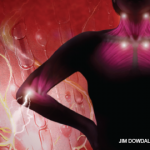Sleep apnea also disproportionately affects many patients with chronic pain. In fact, Ms. Cralle says a particular variant of sleep apnea called upper airway resistance syndrome is very common in women with fibromyalgia, and the incidence of RLS has been found to affect 46–80% of patients with fibromyalgia. Diagnosing and treating the sleep disorder has been shown to improve both fatigue and pain in fibromyalgia patients.
To obtain a diagnosis of sleep apnea, Ms. Cralle says patients are given a test called a polysomnogram. Once traditionally offered only in sleep labs, there are now devices that allow patients to test for sleep apnea in the comfort of their own homes.
If a patient is diagnosed with sleep apnea, they are often prescribed continuous positive airway pressure (CPAP) therapy. CPAP patients sleep wearing a small mask that covers the nose and/or mouth and is connected to a shoebox-size machine by a flexible tube. Gentle air pressure continuously flows through the tube, holding the airway open and allowing patients to breathe normally.
Although CPAP is a highly effective treatment, some patients have problems adjusting to sleeping with the CPAP mask.
“Cognitive-behavior treatments have been found to be the most effective way to improve CPAP use and reduce CPAP discontinuation,” Dr. Gentry says.
Nonpharmacologic Treatments for Insomnia
If a sleep study shows that a patient doesn’t have sleep apnea, there is still a lot that can be done to address their insomnia, says Dr. Gentry, who receives many physician referrals for patients suffering from long-term insomnia.
At her offices in Reno, Dr. Gentry uses cognitive-behavior therapy for insomnia (CBT-I) to treat insomnia, a technique the American Academy of Sleep Medicine and the National Institutes of Health recommend as the standard treatment for insomnia. CBT-I, she notes, is different from regular cognitive-behavior therapy, which doesn’t always work for insomnia. However, CBT-I has proved effective in treating patients with comorbid health problems, chronic pain and depression.
Rheumatologists making referrals to sleep specialists should ensure that specialist has been trained in CBT-I. The American Board of Sleep Medicine has a list of specialists trained in this area, as does the Society for Behavioral Sleep Medicine.
A new study offers compelling evidence of a link between dementia & long-term anticholinergic medications, such as diphenhydramine, & nonprescription sleep aids.
“While sleep medications and antidepressants are commonly used for treatment of insomnia, sleep problems can continue to persist,” Dr. Gentry says. “Typically, it takes three to five sessions with a sleep specialist trained in CBT-I to get to the root causes of a patient’s sleeplessness to effectively treat their insomnia.”


